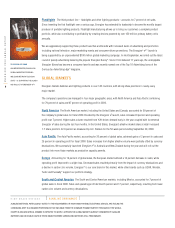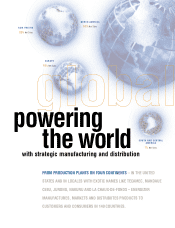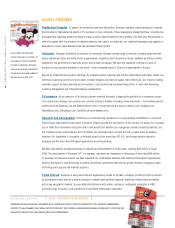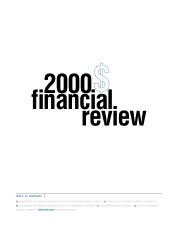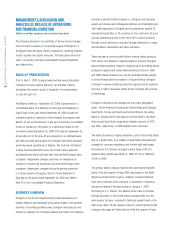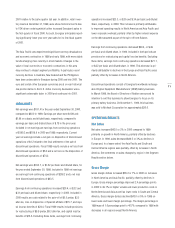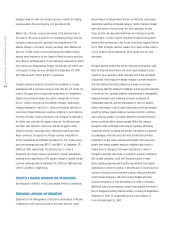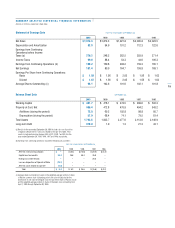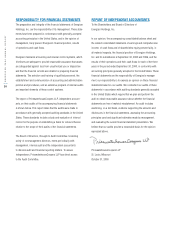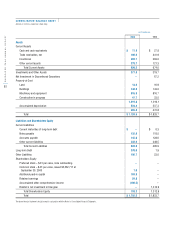Energizer 2000 Annual Report Download - page 17
Download and view the complete annual report
Please find page 17 of the 2000 Energizer annual report below. You can navigate through the pages in the report by either clicking on the pages listed below, or by using the keyword search tool below to find specific information within the annual report.
15
restructuring plans. In addition, $8.5 of termination benefits
recorded in 1997 were reversed in 1998, due primarily to the
modification of a European plant closing plan, driven by the
changing business environment in Europe. The modifications
resulted in the termination of approximately 200 fewer employees
than originally anticipated.
Annual pre-tax cost savings from the 1999 restructuring plans
have been or are expected to be as follows: 2000 – $.3 and $1.4
thereafter. Annual pre-tax cost savings from the 1998 restructuring
plans have been or are expected to be as follows: 1999 – $12.0;
2000 and thereafter – $13.0. Annual pre-tax cost savings from the
1997 restructuring plans have been or are expected to be as follows:
1998 – $9.0; 1999 – $19.0; 2000 and thereafter – $23.0.
As of September 30, 2000, except for the disposition of certain
assets held for disposal, substantially all activities associated with
1994 through 1997 restructuring plans are complete. The remaining
accrual related to these plans was $2.1 at September 30, 2000 and
primarily represents asset disposition costs. The carrying value of
assets held for disposal under all restructuring plans was $6.7 at
September 30, 2000.
Energizer expects to fund the remaining costs of these restructuring
actions with funds generated from operations.
See Note 5 to the Consolidated Financial Statements for a table
which presents, by major cost component and by year of provision,
activity related to the restructuring charges discussed above during
fiscal years 2000, 1999 and 1998, including any adjustments to the
original charges.
Interest and Other Financial Items
Interest expense increased $19.9 in 2000 primarily in the last six
months of the year reflecting incremental debt assumed by Energizer
immediately prior to the spin-off. Interest expense decreased $3.5 in
1999 compared to 1998 primarily due to lower rates on foreign debt.
Other financing-related costs were favorable $4.3 in 2000 compared
to 1999 primarily due to lower foreign exchange losses partially
offset by the discount on the sale of accounts receivable financing
arrangement. Other financing costs were unfavorable $6.0 in 1999
compared to 1998 primarily due to higher foreign exchange losses
in 1999.
Income Taxes
Income taxes, which include federal, state and foreign taxes, were
35.5%, 35.6% and 20.7% of earnings from continuing operations
before income taxes in 2000, 1999 and 1998, respectively. Income
taxes include certain unusual items in all years, the most significant
of which are described below:
• In 2000, the income tax percentage was favorably impacted by
the recognition of $24.4 of U.S. capital loss tax benefits related
to the disposition of Energizer’s Spanish affiliate.
• Capital loss tax benefits of $16.6 and $48.4 were recognized in
1999 and 1998, respectively, and were primarily related to prior
years’ restructuring actions.
• In 1999, the income tax percentage was unfavorably impacted by
pre-tax restructuring provisions that did not result in tax benefits
due to tax loss situations or particular statutes of a country.
Excluding unusual items, the income tax percentage was 41.8% in
2000, 41.3% in 1999 and 39.2% in 1998.
LIQUIDITY AND CAPITAL RESOURCES
Cash flows from continuing operations totaled $289.6 in 2000,
$337.2 in 1999 and $232.6 in 1998. The 14% decrease in cash
flows from continuing operations in 2000 is due primarily to
increased inventory levels and the realization of capital loss tax
benefits in fiscal 1999, partially offset by higher cash earnings and
proceeds from the sale of accounts receivable. The 45% increase in
cash flows from continuing operations in 1999 resulted primarily
from higher cash earnings and also from favorable changes in
working capital items.
Working capital was $401.7 and $478.1 at September 30, 2000
and 1999, respectively. Capital expenditures totaled $72.8, $69.2
and $102.8 in 2000, 1999 and 1998, respectively. These expendi-
tures were primarily funded by cash flow from operations. Capital
expenditures of approximately $90.0 are anticipated in 2001 and
are expected to be financed with funds generated from operations.
Net transactions with Ralston, prior to the spin-off, resulted in
cash usage of $210.7, $293.7 and $154.7 in 2000, 1999 and
1998, respectively.



